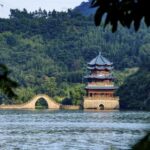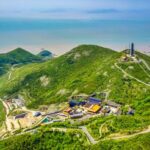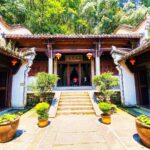Sanhe Ancient Town is located about 40 kilometers south of Hefei urban area. It is named after the three rivers, Fengle River, Hangbu River and Xiaonan River, flowing through it. The ancient town developed from the ancient docks on the Sanhe River. It has a history of more than 2,500 years. In the Spring and Autumn Period, it was called Que’an. It was first called Sanhe Town in the Ming Dynasty. In 1858, Chen Yucheng and Li Xiucheng of the Taiping Heavenly Kingdom defeated the Qing army here, known as the ‘Great Victory of Sanhe’. The old street of the ancient town is paved with bluestone slabs, which have been polished smooth by people and vehicles for thousands of years. The Huizhou-style buildings on both sides are unique. Many of them are directly built with blue bricks. The upturned eaves protruding from the horsehead wall are much more exaggerated than those on the horsehead walls of Hongcun and Xidi. The tour guide generally starts to visit the ancient town from the town center. After taking a long-distance bus to Sanhe Bus Terminal, turn right and walk for 10 minutes. Passing the Dajie Gate archway built to commemorate the ‘Great Victory of Sanhe’, you will come to the three-arch stone bridge Sanxian Bridge in the town center. It is named because it is the junction of Feixi County and Lujiang County in Hefei City and Shucheng County in Lu’an City. The north-south flowing Xiaonan River flows under the bridge. To the northwest of Sanxian Bridge is the Guocui Tower, which is seven stories high. Ascending the tower, you can overlook the panorama of Sanhe Ancient Town. Inside the tower are displayed exquisite Huizhou-style cultural relics such as sedans, plaques, carved beds, and stone carvings. The cultural relics exhibited in Dafudi (Sanhe Folk Custom Museum) near Guocui Tower are also exquisite, including the hall layout of an official’s private residence, beautiful wood carvings, and a large abacus 1.5 meters long. To the northeast of Sanxian Bridge is Xianv Tower (the former site of Zhonghexiang), a Huizhou-style residential temple built by a big businessman at that time. Walking north along the east bank of Xiaonan River from Xianv Tower is the ancient West Street paved with bluestone slabs, which is 500 meters long. It was once the busiest street in the ancient town’s history. There are many traditions. For example, there is the Zhonghexiang pastry shop still in business next to Xianv Tower. Among these traditions, the larger one is Liutongxinglongzhuang, and the interior is still arranged like a shop. In addition, you can also visit Zongxian Root Carving Museum on Ancient West Street. Walking south along the west bank of Xiaonan River from Sanxian Bridge, first look at Quezhu Corridor Bridge on the river with a history of more than 1,500 years. Then on Ancient South Street and Wannian Street, mainly look at the residences. There are the former residence of Yang Zhenning, the former residence of Sun Liren, the ancient entertainment workshop, Helu (the former residence of Liu Bingzhang), etc. In the former residences of celebrities, there are pictures and texts of the owners of the houses. The most famous one is the former residence of Yang Zhenning, who won the Nobel Prize in Physics. At that time, Yang Zhenning lived here to avoid the Japanese war. Near the former residence, there is an interesting alley called One-Person Alley, which is really narrow enough for only one person to pass through. On Wannian Street, you can also visit Wannian Temple, City God Temple, etc. Walking to Ancient East Street on the east bank of Xiaonan River (connected to Ancient West Street and in the south of the ancient town), you can visit the Earth God Temple and the ancient city wall built by the Taiping Heavenly Kingdom Army. At the Wannian Stage, there are Lu Opera performances to watch on holidays.
Dining and Accommodation in Sanhe Ancient Town are mainly concentrated around the Sanxian Bridge area, with more restaurants in the south than the north. Special local delicacies include Sanhe rice dumplings, Sanhe shrimp paste, crispy duck, river delicacies such as clams and snails. Tea-dried tofu, a type of tofu, can be purchased for on-the-go snacking, and rice wine is a great gift to take home. For unique souvenirs, feather fans are recommended. Accommodation is available both within and around the ancient town, reasonably priced at around 100-200 yuan. However, few tourists choose to stay overnight as it is possible to return to the city of Hefei on the same day, making accommodation less necessary. The town is open all year round, accessible 24/7, while smaller attractions and rowing boats operate from 8:30 to 17:30.









